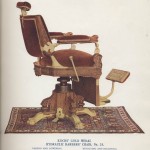
My name is Eleanor Peters and I’m the 2012 Peter A. Krueger Summer Intern at the Cooper-Hewitt National Design Library. I recently graduated from Middlebury College where I studied Art History and Anthropology. Growing up in New York City, I was a frequent patron of the New York Public Libraries. On any given weekend I could be found maxing out my library card with books about everything from Egyptian hieroglyphs to the ecosystem of the Great Barrier Reef. Since then I have always had a love of books and a great appreciation for libraries and book preservation. From my own experiences, whether reading for leisure or doing research for my senior thesis this past spring, libraries have been invaluable resources and centers of boundless learning. Therefore I am excited to spend 10 weeks working with my supervisor, Reference Librarian Elizabeth Broman, to learn what happens behind the scenes at the National Design Library.





